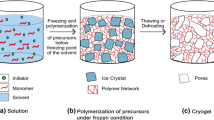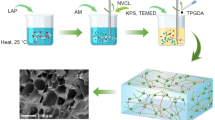Abstract
When the synthesis of hydrogels, which are a hydrophilic group of polymers, occurs below the freezing point of water, the hydrogels gain a perfect property: porosity. Hydrogels with this property and resulting sponge-like structure are called cryogels (CRYs). The porosity of cryogels is affected by the amount of crosslinker used. In this study, how the amount of crosslinker affected the porosity initially was investigated, along with thermal, swelling, and crystallinity properties of polyacrylamide (PAAM) cryogels. Additionally, a series of composites (COMs) were synthesized with polyaniline (PAN) in the pore spaces of CRYs and again the effect of varying pore size on the electrical conductivity of COMs was researched. In the cryogel series, as the amount of N,N′-methylenbisacrylamide (MBA) increased, the pore size increased. The S, P, Ps, and Vp parameters increased in general with the MBA increase. The conductivity values of composites were determined in the interval of 1.6 × 10−3-4.5 × 10−3 S cm−1.

Graphical Abstract


















Similar content being viewed by others
References
Savina IN,Galaev IY (2016) Production of synthetic cryogels and the study of porosity theory, supermacroporous cryogels: biomedical and biotechnological applications. In: Kumar A (ed) CRC Press, pp 91–110
Lozinsky VI, Galaev IY, Plieva FM, Savina IN, Jungvid H, Mattiasson B (2003) Polymeric cryogels as promising materials of biotechnological interest. Trends Biotechnol 21:445–451
Lozinsky VI (2008) Polymeric cryogels as a new family of macroporous and supermacroporous materials for biotechnological purposes. Russ Chem Bull Int Ed 57:1015–1032
Henderson TMA, Ladewig K, Haylock DN, McLeanb KM, O'Connor AJ (2013) Cryogels for biomedical applications. J Mater Chem B 1:2682–2695
Yang C, Zhou X, Liu Y, Wang J, Tian L, Zhang Y, Hu X (2016) Charged groups synergically enhance protein imprinting in amphoteric polyacrylamide cryogels. J Appl Polym Sci 133:1–6
Yang C, Liu G, Zhou X, Liu Y, Wang J, Tian L, Hu X, Wang Y (2015) Polyacrylamide based cryogels as catalysts for biodiesel. Catal Lett 145:1778–1783
Sedlacik T, Proks V, Slouf M, Duskova-Smrckova M, Studenovska H, Rypacek F (2015) Macroporous biodegradable cryogels of synthetic poly(α-amino acids). Biomacromolecules 16:3455–3465
Wang J, Wang Q, Tian L, Yang C, Yu S, Yang C (2015) Research progress of the molecularly imprinted cryogel. Chin J Anal Chem 43:1777–1784
Sapurina I, Stejskal J (2008) The mechanism of the oxidative polymerization of aniline and the formation of supramolecular polyaniline structures. Polym Int 57:1295–1325
Mostafaei A, Zolriasatein A (2012) Synthesis and characterization of conducting polyaniline nanocomposites containing ZnO nanorods. Prog Nat Sci-Mat 22:273–280
Sedenkova I, Trchova M, Stejskal J (2008) Thermal degradation of polyaniline films prepared in solutions of strong and weak acids and in water-FTIR and Raman spectroscopic studies. Polym Degrad Stabil 93:2147–2157
Gurunathan K, Amalnerkar DP, Trivedi DC (2003) Synthesis and characterization of conducting polymer composite (PAn/TiO2) for cathode material in rechargeable battery. Mater Lett 57:1642–1648
Jia W, Segal E, Kornemandel D, Lamhot Y, Narkis M, Siegmann A (2002) Polyaniline-DBSA/organophilic clay nanocomposites: synthesis and characterization. Synthetic Met 128:115–120
Peng C, Zhang S, Jewell D, Chen GZ (2008) Carbon nanotube and conducting polymer composites for supercapacitors. Prog Nat Sci 18:777–788
Li D, Huang J, Kaner RB (2009) Polyaniline nanofibers: a unique polymernanostructure for versatile applications. Acc Chem Res 42:135–145
Stejskal J, Gilbert RG (2002) Polyaniline. Preparation of a conducting polymer (IUPAC technical report). Pure Appl Chem 74:857–867
Blinova NV, Stejskal J, Trchova M, Prokes J (2008) Control of polyaniline conductivity and contact angles by partial protonation. Polym Int 57:66–69
Molapo KM, Ndangili PM, Ajayi RF, Mbambisa G, Mailu SM, Njomo N, Masikini M, Baker P, Iwuoha II (2012) Electronics of conjugated polymers (I): polyaniline. Int J Electrochem Sci 7:11859–11875
Cardoso MJR, Lima MFS, Lenz DM (2007) Polyaniline synthesized with functionalized sulfonic acids for blends manufacture. Mater Res 10:425–429
Bhadra S, Khastgir D, Singhaa NK, Lee JH (2009) Progress in preparation, processing and applications of polyaniline. Prog Polym Sci 34:783–810
Carvalho BMA, Da Silva SL, Da Silva LHM, Minim VPR, Da Silva MCH, Carvalho LM, Minim LA (2014) Cryogel poly(acrylamide): synthesis, structure and applications. Sep Purif Rev 43:241–262
Gun'ko VM, Savina IN, Mikhalovsky SV (2013) Cryogels: morphological, structural and adsorption characterisation. Adv Colloid Interf Sci 187:1–46
Xu F, Zheng G, Wu D, Liang Y, Li Z, Fu R (2010) Improving electrochemical performance of polyaniline by introducing carbon aerogel as filler. Phys Chem Chem Phys 12:3270–3275
Tang Q, Wu J, Sun H, Lin J, Fan S, Hu D (2008) Polyaniline/polyacrylamide conducting composite hydrogel with a porous structure. Carbohyd Polym 74:215–219
Tang Q, Wu J, Sun H, Fan S, Hu D, Lin J (2007) Superabsorbent conducting hydrogel from poly (acrylamide-aniline) with thermo-sensitivity and release properties. Carbohyd Polym 73:473–481
Okay O, Lozinsky VI (2014) Synthesis and structure–property relationships of cryogels. Adv Polym Sci 263:103–157
Okay O (2000) Macroporous copolymer networks. Prog Polym Sci 25:711–779
Bhattacharya P, Dhibar S, Hatui G, Mandal A, Das T, Das CK (2014) Graphene decorated with hexagonal shaped M-type ferrite and polyaniline wrapper: a potential candidate for electromagnetic wave absorbing and energy storage device applications. R Soc Chem 4:17039–17053
Xu H, Zhang J, Chen Y, Lu H, Zhuang J (2014) Electrochemical polymerization of polyaniline doped with Cu2+ as the electrode material for electrochemical supercapacitors. R Soc Chem 4:5547–5552
Gundogan N, Okay O, Oppermann W (2004) Swelling, elasticity and spatial ınhomogeneity of poly(N, N-dimethylacrylamide) hydrogels formed at various polymer concentrations. Macromol Chem Phys 205:814–823
Okay O, Kurz M, Lutz K, Funke W (1995) Cyclization and reduced pendant vinyl group reactivity during the free-radical crosslinking polymerization of 1, 4-divinylbenzene. Macromolecules 28:2728–2737
Funke W, Okay O, Joos-Müller B (1998) Microgels-intramolecularly crosslinked macromolecules with a globular structure. Adv Polym Sci 136:139–234
Ansari R, Price WE, Wallace GG (1996) Effect of thermal treatment on electroactivity of polyaniline. Polymer 37:917–923
Pandey SS, Gerard M, Sharma AL, Malhotra BD (2000) Thermal analysis of chemically synthesized polyemeraldine base. J Appl Polym Sci 75:149–155
Mentus S, Ciric-Marjanovic G, Miroslava T, Stejkal J (2009) Conducting carbonized polyaniline nanotubes. Nanotechnology 20:245601
Bhandra S, Khastgir D (2008) Extrinsic and intrinsic structural change during heat treatment of polyaniline. Polym Degrad Stab 93:1094–1099
Bhat NV, Joshi NV (1993) Investigation of the properties of polyacrylamide-polyaniline composite and its application as a battery electrode. J Appl Polym Sci 50:1423–1427
Dai T, Qing X, Wang J, Shen C, Lu Y (2010) Interfacial polymerization to high-quality polyacrylamide/polyaniline composite hydrogels. Compos Sci Technol 70:498–503
Verma PK, Sardar PS, Ghosh S, Biswas M (2009) Conducting nanocomposites of polyacrylamide with acetylene black and polyaniline. Polym Compos 30:490–496
Xiang Q, Xie HQ (1996) Preparation and characterization of alkali soluble polyacrylamide-g-polyaniline. Eur Polym J 32:865–868
Das B, Kar S, Chakraborty S, Chakraborty D, Gangopadhyay S (1998) Synthesis and characterization of polyacrylamide–polyaniline conductive blends. J Appl Polym Sci 69:841–844
Prabhakar R, Kumar D (2016) Influence of dopant ions on the properties of conducting polyacrylamide/polyaniline hydrogels. Polym-Plast Technol Eng 55:46–53
Acknowledgments
The authors would like to express their thanks to Assoc. Prof. Dr. Barbaros Demirselcuk (Canakkale Onsekiz Mart University, Technical Sciences Vocational School, Department of Energy and Electric) for conductivity measurements.
Funding
This research was supported by the Scientific Projects Commission of Canakkale Onsekiz Mart University, 2017/1341.
Author information
Authors and Affiliations
Corresponding author
Ethics declarations
Conflict of interest
The authors declare that they have no competing interests.
Additional information
Publisher’s note
Springer Nature remains neutral with regard to jurisdictional claims in published maps and institutional affiliations.
Rights and permissions
About this article
Cite this article
Celik, M.U., Ekici, S. Polyacrylamide-polyaniline composites: the effect of crosslinking on thermal, swelling, porosity, crystallinity, and conductivity properties. Colloid Polym Sci 297, 1331–1343 (2019). https://doi.org/10.1007/s00396-019-04545-y
Received:
Revised:
Accepted:
Published:
Issue Date:
DOI: https://doi.org/10.1007/s00396-019-04545-y




